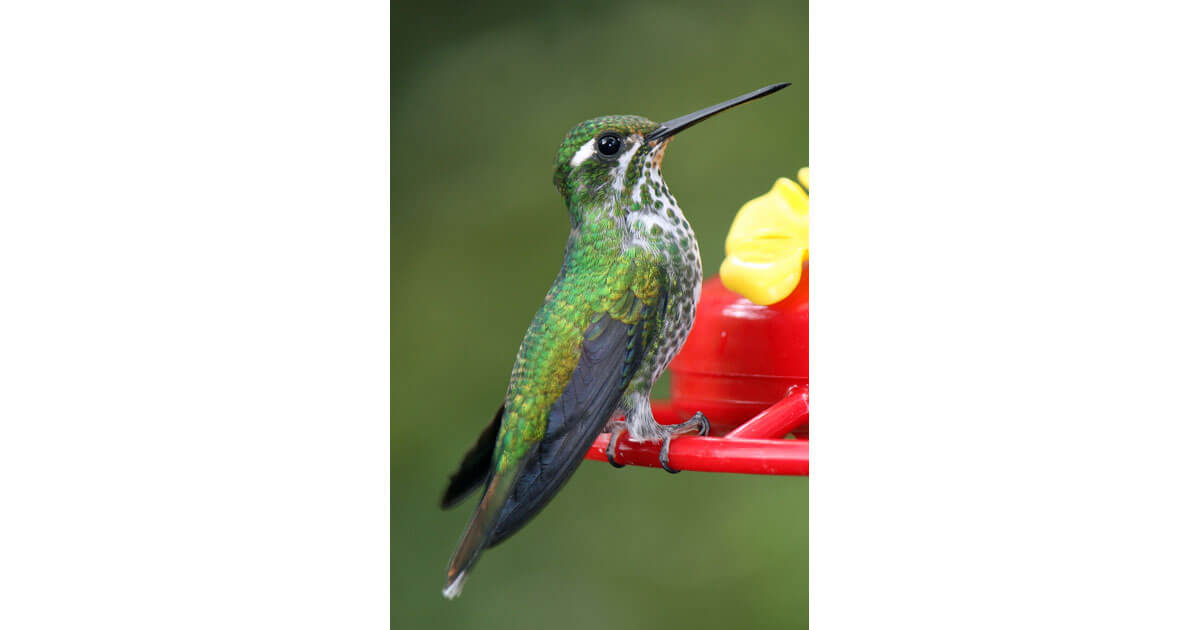WILDLIFE ADVENTURE IN ECUADOR
By Melanie Votaw
 Publisher of TripOutonTravel.com, travel, writer and photographer Melanie Votaw talks about her amazing bird and wildlife watching adventures in Ecuador on Big Blend Radio.
Publisher of TripOutonTravel.com, travel, writer and photographer Melanie Votaw talks about her amazing bird and wildlife watching adventures in Ecuador on Big Blend Radio.
Ecuador is among the top 10 most biodiverse countries in the world. Only five other countries have more bird species, and it’s number one when it comes to hummingbird species. All of this is remarkable considering the nation’s small size.
Of course, most travelers think of the Galapagos Islands when they think Ecuador, but the country also includes the Amazon River and the Andes mountain range, making it a perfect destination for nature lovers. In December 2017, I visited all three regions for a 16-day “wildlife extravaganza.”
First, the Galapagos. This volcanic archipelago is isolated in the Pacific Ocean, straddling the Equator. That isolation made the islands perfect for Charles Darwin to develop his theory of evolution. He could see the slight changes in the endemic species of animal life from island to island – differences that you can often still see today, especially in the smaller birds. It does make species identification downright confounding at times, though. Is that a large, medium, or small Darwin finch? Your guess is as good as mine!
What makes the Galapagos so thrilling, however, is that it’s like a natural zoo. The animals aren’t afraid of humans because they have almost no predators, are well-protected, and often live on islands uninhabited by people. In fact, humans live on only four of the 22 islands. The government polices where you go and when, so there are never many people on an uninhabited island. While you aren’t supposed to get closer to the animals than two meters, there are times when the animals come closer to you!
For my visit, I flew from Quito to the island of San Cristobal, where I boarded a Latin Trails yacht for a six-day/five-night cruise around the islands. Our three-deck boutique yacht called the “Galapagos Sea Star Journey” had about a dozen crew members and 14 guests from the U.S. and Europe. It was the height of luxury with unusually spacious staterooms and delicious food. Our stateroom even had a balcony big enough for two chairs.
The sun deck contained lounge chairs and two Jacuzzis, where we often sipped Pisco sours while watching the spectacular sunsets and the frigatebirds as they chased each other overhead. Sometimes, the frigates even perched on top of our vessel.
Each night, our naturalist guide gave us a briefing about the islands we’d visit the following day and the animals we’d see. We managed to see seven islands, often sailing overnight and climbing into two dinghies just after breakfast. During the trip, we saw giant tortoises, black and red marine iguanas, deep yellow land iguanas, bright red crabs, blue-footed boobies, white and brown Nazca boobies, Galapagos hawks, more sea lions than we could count, including many newborns, and a variety of bird life. It was especially exciting to see the male frigatebirds in full display with their red throats inflated.
After that dream excursion, I flew to the mining town of Coca for my visit to the Amazon, which couldn’t have been a more different experience. While the Galapagos Islands are often rocky and stark with cacti and leafless trees, the Amazon is lush, dense, and deep green. This density makes the wildlife considerably more challenging to find. Binoculars are a necessity, but then, out of nowhere, a group of squirrel monkeys or a pair of large hoatzin birds (which the locals call “stinky turkeys” because of their odor) will suddenly appear out in the open as you ride by in your canoe.
I stayed at La Selva Lodge and Spa, which is as luxurious as you can get in the remote jungle. From Coca, we boarded a large motorized canoe with a roof for a two-hour ride down-river, followed by a 30-minute paddle canoe ride to the thatch-roofed lodge, which is thankfully devoid of malaria.
My room at La Selva was on par with any 5-star hotel. I had a balcony that contained a table and chairs, a living area, queen-sized bed with mosquito net canopy, bathroom with two sinks, shower, safe, and bathrobe. (There’s no minibar, however, because food might attract unwelcome animals and insects.) The luxury continued in La Selva’s dining room, where I felt like I was eating at a Michelin star restaurant.
Since I’m a birdwatcher, I had a private guide who took me out on walks in rubber boots or canoe rides each day to find birds and other animals. I was especially keen to see a pygmy marmoset, the smallest monkey in the world, but my guide, Rodrigo, told me they’re rarely seen in the area. Then, lo and behold, within a half hour, he’d found one for me within binocular range. I particularly loved our peaceful paddle canoe rides through narrow tributaries with only the sound of the animals, insects, and water around us.
After I spent three nights at La Selva, I flew back to Quito and was picked up for a drive to the nearby Yanacocha Reserve at almost 12,000 feet to see birds such as the sword-billed hummingbird with its 4-1/2-inch bill. Then, I was delivered back down at 5,500 feet to Tandayapa Bird Lodge in the Andes. The lodge straddles the hemispheres in a remote subtropical cloud forest 40 miles northwest of Quito and just 200 yards from the Southern Hemisphere.
The accommodations at Tandayapa are modest compared to the Sea Star and La Selva, but the food is memorable. The chefs from the local village cook Ecuadoran cuisine, which is famous for puréed soups garnished with popcorn.
The biggest draw to Tandayapa, however, is its prime location for bird life. At certain times of the year, feeders on the lodge’s veranda attract as many as 100 hummingbirds representing 30 species. It’s truly a hummingbird circus. During birdwatching excursions away from the lodge, you can see avian treasures like the Andean cock-of-the-rock, colorful tanagers, quetzals, parrots, and toucans.
With so much diversity in a small country, Ecuador provides the wildlife lover with unique opportunities to see animals that can’t be seen anywhere else. What are you waiting for?
Melanie Votaw is the author of 28 non-fiction books on a variety of subjects, six under her own name published by Running Press/Perseus Books and 22 ghostwritten. She has contributed to three additional books, two of which are compilations of short fiction. Books that she has ghostwritten or edited have won more than 35 awards, including the Best Beach Books Festival Grand Prize, and one of her edited books made the New York Times Bestseller List. Melanie has also written articles for numerous magazines, and runs her own travel and entertainment blog called www.TripOutonTravel.com . Her photography has been published in magazines and books, such as “The Ultimate Bird Lover” published by Health Communications, Inc. Melanie has traveled to nearly 50 countries on six continents and loves to write about luxury travel, family travel, eco experiences, wildlife viewing and bird watching, food, wine, history, and culture. She is a member of the International Food Wine & Travel Writers Association.


















Leave a Comment
You must be logged in to post a comment.